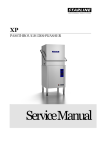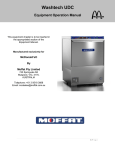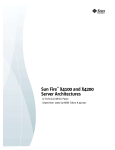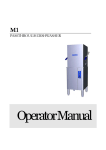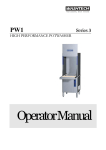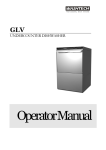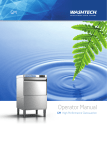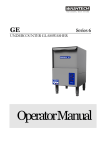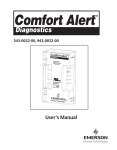Download Washtech XP Service manual
Transcript
XP PASSTHROUGH DISHWASHER ServiceManual WARNING Before installation and commissioning, you must read the safety instructions and warnings carefully and all the warning labels attached to the equipment. ! ! IMPORTANT Failure to comply (even partially) with the instructions given in this manual will invalidate the product warranty and relieves the manufacturer of any responsibility. IMPORTANT The alteration of machine operation, design or the replacement of parts not approved by the manufacturer may void warranties and approvals. We have checked that the contents of this document correspond to the model described. There may be discrepancies nevertheless, and no guarantee can be given that they are completely identical. The information contained in this document is reviewed regularly and any necessary changes will be included in the next edition. We welcome suggestions for improvement. Document subject to change without prior notice. Information supplied in this manual is copyright. No part of this work may be reproduced or copied in any form or by any means, electronic or mechanical without the express permission of the author / publisher. Service Manual XP-2 2 Revision 1C Contents Safety Instructions ...........................................................................................................................................................................4 Installation...........................................................................................................................................................................................5 Installation Diagram ............................................................................................................ 6 Bench Details........................................................................................................................ 7 Installation Checklist ........................................................................................................... 8 Maintenance Checklist ........................................................................................................ 9 Dishwashing Procedures .......................................................................................................................................................... 10 Troubleshooting Chart............................................................................................................................................................... 12 Operating Instructions............................................................................................................................................................... 14 Components .................................................................................................................................................................................... 15 Location and Access..........................................................................................................15 Timer....................................................................................................................................16 Rinse Thermostat...............................................................................................................17 Wash Thermostat...............................................................................................................18 Solenoid Valve....................................................................................................................19 Pressure Switch ..................................................................................................................20 Wash Pump.........................................................................................................................21 Detergent Pump.................................................................................................................22 Rinse Aid Injector..............................................................................................................23 Assembly & Electrical Diagrams.......................................................................................................................................... 24 Wiring Tray Assembly.......................................................................................................24 Control Panel Assembly ...................................................................................................25 Wash Assembly ..................................................................................................................26 Rinse Assembly ..................................................................................................................27 Rinse Tank Assembly ........................................................................................................28 Door Assembly ..................................................................................................................29 Door Link Assembly .........................................................................................................30 Rack Slide Assembly..........................................................................................................31 Schematic Diagrams ..........................................................................................................32 Wiring Diagram..................................................................................................................33 Spare Parts ........................................................................................................................................................................................ 34 Accessories ....................................................................................................................................................................................... 36 Appendices....................................................................................................................................................................................... 37 Rinse Pump Retrofit ................................................................................................................................ 37 Revisions............................................................................................................................................................................................ 38 Service Manual XP-2 3 Revision 1C Safety Instructions WARNING Equipment contains dangerous voltages and can be hazardous if installed or operated incorrectly. Non-compliance with Warnings or failure to follow the instructions contained in this manual can result in loss of life, severe personal injury or serious damage to property. Installation Use qualified, skilled personnel Follow installation instructions Connect to correct voltage and supply current Provide fully accessible Electrical Isolation Switch & water supply valves Training and Supervision Read and Understand the Operating instructions and train all staff This appliance must not be operated by children or infirm persons Machine panels must only be removed by suitably qualified and trained personnel – internal hazards include live electrics and very hot surfaces This appliance is not intended for use as a stepladder Hot Surfaces Some surfaces may be hot or very hot Chemicals Commercial dishwashing detergents are hazardous – handle with care Read and follow the safety information found on the labels of detergent containers and Material Safety Data Sheets Use protective eyewear and clothing if decanting containers Hot Water Do not put hands in wash water which may be over 60°C and contain hazardous caustic detergent Rinse water can be over 90°C Door safety switches are designed for emergency use only Cleaning Do not hose down the machine or splash water over the exterior Watch for broken glass etc when cleaning the inside of the machine Power Cord Replacement If the supply cord is damaged, it must be replaced by the manufacturer or its service agent or a similar qualified person in order to avoid a hazard Service Manual XP-2 4 Revision 1C Installation WARNING Installer must be suitably qualified and ensure compliance with all codes and standards including AS/NZS3500.1. ! Failure to comply even partially with installation instructions may void the warranty. Positioning Unpack machine, check for damage and complete delivery. Install machine on sound waterproof self-draining floor and use adjustable feet to level machine. Allow room for detergent to one side of machine or in adjacent cupboard. 20litre container requires about 450H x 250W x 350D, but smaller containers are available from many suppliers. Benchwork Refer Bench Details diagram. In corner installations the front of the machine must face to the left of the corner. In corner installations high or angled bench return off wall may clash with door handle. Level and secure machine and benches. Adjust to ensure smooth travel of rack through machine. Water Supply Hot water temperature 65°C ± 5°C Connection 20 mm (3/4" BSP Male) Flow rate minimum 20 litres per minute Consumption per cycle 2.6 litres approximately Backflow prevention DCV = Dual Check Valve fitted standard Pressure 200-350 KPa = 30-50 Psi. Above this range fit pressure limiter. Don’t use small diameter plastic supply lines especially below this range when optional rinse booster pump may be required. FLUSH supply line before connection. Poor quality supply or excessive water hardness may affect performance or damage machine – filtration and/or softening is recommended. Waste 40 mm gravity drain – refer point B on installation diagrams – run waste directly behind the machine or through open base. Power 15A 240V 50Hz via switched outlet adjacent to machine, which is supplied with cord set including 15A plug. Machine may also be installed on 3 Phase, Neutral and Earth, 415V 50Hz 15A/ph, permanently wired via wall switch mounted adjacent to machine – refer schematic diagram for this requirement. Detergent Insert detergent pump inlet hose into container of commercial low foam detergent. Open machine door and switch machine on. Press and hold detergent prime switch behind front cover until chemical flows into machine. Rinse Aid Insert injector inlet hose into rinse aid container. Check amount of fluid rising up inside pipe during pulse at start of rinse cycle. Rotate adjusting screw clockwise to reduce flow and anticlockwise to increase flow. Installation Checklist Complete attached Installation Checklist to ensure machine is installed and running correctly, and operator is familiar with operating procedures. Troubleshooting If the machine doesn’t fill after switching on the power, check and ensure that the hot water supply tap is open, water supply pressure is not below specification and Dual Check Valve is not faulty and correctly installed (arrows on the dual check valve’s body specify water flow direction). Service Manual XP-2 5 Revision 1C Service Manual XP-2 6 Revision 1C Service Manual XP-2 7 Revision 1C Installation Checklist CHECK Delivery Supplied complete Position Level and stable Water Isolator valve fitted DCVs fitted (Washtech only) Temperature Flow rate Pressure Cold water when required Hardness Power Isolating switch Supply as specified Waste Usually 40 mm Air gap on pumped drain Chemicals product name Detergent Rinse Aid Machine operation Run several cycles Confirm correct operation Operator training OK / NOTES no transit damage on sound, waterproof, self draining floor Accessible, all fittings sound, no leaks Correct direction 65 ± 5°C Minimum 20 litres per minute 200-350 kpa, limiter fitted if above this range Booster fitted if below this range Pressure not above 350 kpa Filter or softening if required Fitted, functional and accessible Voltage, current, circuit breaker Sound, no leaks container no leaks primed conc.OK Including correct fill levels Confirm Operator has copy of Operator Manual and is familiar with procedures Start-up Pre-rinse and racking Machine operation Drain Clean Shut-down Service Manual XP-2 Model / Serial Owner Location Technician Date Signed 8 Revision 1C Maintenance Checklist CHECK OK / NOTES Installation – use Installation Checklist on previous page to check all services, operator training and chemical issues Services water, power, drain etc. Operator trained / has instructions Chemicals squeeze tube checked – replacement recommended every 6 months, product type, container, leaks etc. General conditions Cleanliness of machine daily maintenance Presence of pests Leaks Operation Temp °C Amps Elements Wash 60 Rinse 83 Pumps Wash n/a Rinse n/a Drain functional n/a Water Flow Wash arms and jets jets clear, good rotation, bushes OK Rinse arms and jets jets clear, good rotation, bushes OK Cycle Fill levels pressure switch settings Drain operation upstand/pump Noise sounds OK Recovery between cycles Controls Door switch including auto start if fitted Switches, lights, gauges all sound and functional including door/s Performance Wash and rinse effective Electrical Safety test if required Cabinet Door / Handle / Catch operational Rack slide good rack entry / withdrawal Comment / Action Required Model / Serial Owner Location Service Manual XP-2 Technician Signed Date 9 Revision 1C Dishwashing Procedures for best results Note: these are general instructions to assist in getting the best performance from Washtech dishwashers – some comments and / or illustrations may not apply to every unit. Installation Read the Operator Manual. Correct installation, including an adequate supply of water at the correct temperature and pressure is essential for effective operation of your machine. Refer installation instructions for details. Drain hose outlet height is important on some models. Always install on a sound self-draining floor. Water softening is recommended in hard water areas - especially for glasswashing Pre-rinsing Pre-scraping of dishes is required by hygiene regulations. The best method is to pre-rinse with a pre-rinse spray unit or alternatively by scraping or dunking in water. Cutlery Procedures Pre-soak cutlery in warm water, preferably containing cutlery pre-soak compound - refer your chemical supplier. Do not overfill cutlery containers. Cutlery should be loose with handles down. Sort after washing rather than before. Cutlery of only one type nests together and obscures wash water. Racking Procedures Do not overload racks, minimize the overlap of crockery. Cycle times are short and water consumption per cycle low - so there is no advantage in overloading racks. Cycle Times For multi-cycle machine use the longest cycle whenever possible. Note that water consumption does not increase with longer cycles. Only choose shorter, faster cycles when necessary. Detergent Use of correct type and quantity of low foaming commercial grade detergent is essential to the performance of the machine. We strongly recommend that you use a professional dishmachine chemical supplier - and will be pleased to recommend a supplier in your region. Discuss with them the use of cutlery pre-soak solution, detergent and drying agent. Service Manual XP-2 10 Revision 1C Dishwashing Procedures for best results Drying Single tank commercial dishwashers do not have a drying cycle. However, the machines do rinse at high temperatures which promote fast drying particularly when drying agents are used. We recommend prompt removal of the rack from the machine - leave the rack on the bench for 2 to 3 minutes before emptying. This time will be reduced with correct use of drying agent (rinse fluid) which reduces water surface tension and allows water to drain quickly from washware. For advice on drying agents and injectors refer to your chemical supplier. Daily Cleaning It is essential that the machine is drained and cleaned at the end of each day. Drain the machine then remove, clean and replace filters as per the operating instructions. Regularly check the wash and rinse jets and clean them if necessary – see below. Regular Cleaning Remove scrap trays and wash pump inlet filter, where fitted, and rinse or brush clean. Remove wash and rinse arms by undoing the central thumbscrews. If necessary, remove the end cap screws from the wash arms and the end screws from the rinse arms and flush the arms with water and/or use a toothpick or paperclip to clear jets. Note: arms and filters vary with model and may appear different from this illustration e.g. those models with plastic wash arms have removable jets for ease of cleaning Regular Servicing Regular servicing is essential for optimum performance and long machine life. Maintenance is recommended at least once every six months – especially when chemical injectors are fitted. Please contact Moffat or your Authorised Service Provider to organize regular servicing of the dishwasher - discuss a Preventative Maintenance Agreement. Note: these are general instructions to assist in getting the best performance from Washtech dishwashers – some comments and / or illustrations may not apply to every unit. Service Manual XP-2 11 Revision 1C Troubleshooting Chart PROBLEM POSSIBLE CAUSES REMEDY (Check/Adjust/Replace) Water supply valve shut Door switch faulty Solenoid valve faulty Rinse lines blocked Pressure switch faulty Water supply valve Door switch Solenoid valve Rinse pump, solenoid valve filter Pressure switch Won't stop filling Solenoid valve faulty Pressure switch set too high/faulty Pressure bell blocked, hose broken Solenoid valve Pressure switch Pressure bell, hose, hose connections Filling during wash cycle Heating Rinse not heating Pressure switch refill level too high Upstand does not fit properly Pressure switch Drain upstand Over-temp thermostat tripped Rinse thermostat settings or fault Rinse element faulty Over-temp thermostat, rinse element Rinse thermostat Rinse element Overheating Thermostat adjustment Thermostat probe out of pocket Thermostat Insert & secure probe Wash water cold Wash thermostat set too low Wash element faulty Machine not rinsing Rinsing but not hot Rinsing cycle too short Wash thermostat Wash element Solenoid valve, water supply Thermostats & elements, water supply Timer Not up to temperature Rinse thermostat faulty Door switch faulty Give machine reasonable time initially Rinse thermostat Door switch Solenoid jammed open Timer stuck Pressure switch faulty Solenoid valve Timer Pressure switch Timer jammed Timer / Timer motors Timer faulty Timer / Timer motors Filling Not filling Cycle start Does not start Cycle finish Rinse doesn’t stop Wash continues Cycle time Cycle too long Cycles selection (for multi-cycle machines) Time not changed Selector switch faulty Advance timer motor faulty Timer micro switches faulty Delays At start or Rinse element faulty between Water supply cold cycles Water supply pressure excessive Rinse cycle too long Service Manual XP-2 12 Selector switch 6 sec advance timer motor T4 or T5 timer micro switches Rinse element Supply hot water Restrict supply pressure Timer Revision 1C Troubleshooting Chart PROBLEM POSSIBLE CAUSES REMEDY (Check/Adjust/Replace) Drainage Flooding Drain waste blocked Drain waste Leaks Leak from pumps Seal failure Pump seal Leak from hoses Hose damage Hose clamp loose Hoses Hose clamps Splash from door Wash arm end caps missing Wash jets blocked Wash jets missing Arms not rotating Arms not level End caps Wash arm jets Wash arm jets Arms and bushes Arms Wash jets not clean Arm bushes worn Wash pump not working Wash jets Bushes Wash pump Rinse jets not clean Arm bushes worn Water supply pressure low Rinse pump not working (if fitted) Rinse jets Bushes Water supply Rinse pump (if fitted) Rinse pump squeals Low pressure / blocked water supply Noisy wash cycle Performance Poor wash result Wash pump noisy Wash pump including inlet filter Detergent not used Detergent pump faulty Squeeze tube to be replaced Overloading racks Not pre-rinsing Wash arms not rotating Wash jets blocked Low wash pressure through arms Wash temperature low Excessive soiling Unrealistic expectation Poor rinse results Rinse jets blocked Rinse arms not turning Poor racking procedures Excessive wash tank soil build up Use quality low foam product Detergent pump Detergent pump squeeze tube Do not overload racks Use Fisher pre-rinse Remove and clean arms/check bushes Remove arms and clean jets Wash pump impellor Check wash /rinse heating Pre-rinse/use long cycle E.g. baked on soiling requires presoaking Remove arms and clean jets Remove arms, clean jets, check bushes Do not overload racks Pre-rinse, change wash water regularly Not drying Poor wash/rinse performance Low temperatures Drying agent not used Refer above Check heating systems Use quality drying agent/rinse fluid Wash Arms Not rotating Rinse Arms Not rotating Noise Noisy rinse cycle Service Manual XP-2 13 Revision 1C XP Operating Instructions Start up Fit drain upstand, wash pump filter, scrap tray and shut door. Turn wall power switch on and select any cycle (1, 2 or 3). Power light glows red and machine fills automatically. Wash Ready light (water symbol) glows amber when wash tank is ready. Rinse Ready light (tick symbol) glows amber when the machine is up to required temperature. Operation Select required cycle (1, 2 or 3 for 1, 2 or 3 minute cycle accordingly). Try cycle 3 initially and switch to faster cycles only if necessary. Load rack into machine and close door to start the machine. Cycle light glows green while machine operates. When Cycle light goes out, cycle is complete NOTE: Machine might operate longer than specified above if hot water supply temperature is below required. After removing rack from machine, DO NOT shut door as machine will start up again. Shut down every night Turn machine and wall power switches off. Remove drain upstand to drain wash tank. Remove scrap tray and wash pump filter and rinse clean. Replace drain upstand, filter and scrap tray. Service Manual XP-2 14 Revision 1C Components WARNING All service/repair work must be carried out by qualified personnel only. Location and Access 13. 14. 15. 16. 17. 18. 19. 20. 21. 22. 23. 24. 1. Rinse Tank 2. Rinse Safety Thermostat 3. Rinse Heating Element 4. Test Switch 5. Detergent Pump 6. Rinse Thermostat 7. Wiring Tray 8. Detergent Prime Switch 9. Door Switch Relay 10. Heating Contactor 11. Timer 12. Power/Chemical Terminal Service Manual XP-2 15 Dual Check Valve Fill/Rinse Solenoid Valve Wash Pump Pressure Switch Door Switch Wash Thermostat Rinse Aid Injector Wash Heating Element Temperature Gauges Control Panel Assembly Indicator Lights Power/Selector Switch Revision 1C Timer Part Number 32822 Function Provides an automatic timing sequence of the wash, rinse, detergent and rinse aid injection stages in a dishwashing cycle. Description The electromechanical timer has a main drive motor and gearbox which produce a full rotation of the seven cams in 180 seconds. The advance motor and gearbox speed the rotation of the timer to produce shorter cycles of 60 and 120 seconds. The timer cams operate individual changeover switches in sequence during the rotation. The cams are numbered from the main motor end. T1 controls the main motor, T2 – wash pump, T3 – rinse solenoid, T4 – rapid advance motor for 60s cycle, T5 – rapid advance motor for 120s cycle, T6 – detergent injector if fitted, T7 provides thermostop function. Diagram Replacement To replace the timer take note of the position of each connection, preferably on paper. Disconnect all wires and remove the timer from the tray. Compare the cam setting of the old and new timer to ensure that special settings are duplicated. Fit new timer taking care to locate cam T1 in the same relative position. Reconnect the wires ensuring that no termination is under strain. Test the machine to confirm correct operation. Adjustment The timer cams T2, T3, T6 and T7 are adjustable. The time settings on these cams can be increased by making the gap in a cam wider, or reduced by reducing the gap. Use a timer adjusting tool, supplied with the machine to modify a gap in the timer cams. NOTE: To increase (or decrease) detergent injection time adjust only the red sector of the cam T6. The yellow sector sets the beginning of the detergent injection at the start of the shortest wash cycle. If injection time is extended by yellow sector adjustment it will be skipped on fast cycles. ! Service Manual XP-2 IMPORTANT The factory setting of the cam T3 allows for a 12 sec hot rinse. Reduction of this time is prohibited by Health regulations. Extending this setting will increase hot water consumption of the machine and may result in delays between the cycles as this additional water is heated. 16 Revision 1C Rinse Thermostat Part Number 3020 Function Controls the rinse heating elements and prevents operation of machine if the rinse temperature is below that required. Description The rinse thermostat is a specially calibrated 3 pole capillary type temperature operated device. The thermostat does not have a control knob and it is factory set to the temperatures required by Hygiene Regulations. The first pole’s LTCO changeover contact is set to operate at 83 ±3°C, the other two poles HTCO contacts are set to 90±3°C. Switching capacity: 16(4) A 380 V. ! IMPORTANT Do not break the seal or attempt to adjust the central multi pole adjusting screw that is sealed with red compound. Diagrams DO NOT TOUCH LTCO – Low Temp Cut Out HTCO – High Temp Cut Out Replacement Take note of the connections to the wiring loom before disconnecting. Remove the capillary bulb from the rinse tank pocket. Select a new thermostat and carefully unwind enough capillary to reach from the pocket to the thermostat mounting position. Carefully position the tube with no kink or stress on the tube, also have due regard for the protection of the tube against contact with live electrical terminals – secure or insulate as appropriate. Adjustment The thermostat is factory set to the specified above settings and it should not normally be adjusted. If you are sure adjustment is required, remove the grey tape covering three adjusting screws for LTCO and HTCO settings (one or both HTCO poles are used depends on model – check which HTCO terminals are wired before making adjustments). Insert the thermo junction into the rinse tank pocket for the machine’s temperature gauge. Energize the elements and check all temperatures on temperature rise. Clockwise rotation of the screws increases the setting, anticlockwise – decreases it. Every half turn of the adjusting screw changes the settings by approximately 6 degrees. ! Service Manual XP-2 IMPORTANT To make adjustments to the thermostat you will need a good quality thermometer fitted with a “type K” thermo junction. The use of a stainless steel probe is not permitted as slow response time in the device will cause inaccurate settings. 17 Revision 1C Wash Thermostat Part Number 30201 Function Controls the wash element Description The wash thermostat is a single pole capillary type device. It has a single changeover contact and a rotating shaft for a manual temperature adjustment. Factory default setting is 65°C. Contact switching capacity: 16(4) A 380 V. Diagram Replacement Drain the wash tank. Take note of the connections to the wiring loom before disconnecting. Release thermostat’s gland nut, move the capillary bulb out of the mounting bracket inside the tank and remove the bulb from the wash tank (remove the probe from the pocket in the wash tank on the models supplied with a pocket for the thermostat probe). Replace in reverse order. Adjustment Insert the probe of a digital thermometer into the wash tank. Check the thermostat settings on a temperature rise. Adjustment is performed by rotating the adjustment shaft of the thermostat. Clockwise rotation of the shaft increases the setting, anticlockwise– decreases it. NOTE: the adjustment shaft in a flat horizontal position is a factory default setting corresponding to 65°C (see the diagram). Service Manual XP-2 18 Revision 1C Solenoid Valve Part Number 3342 Function Controls flow of water into machine during filling of wash tank and final rinsing. Description Electromagnetically operating water valve for use with cold and hot water. Diagram Replacement Disconnect the wires from the solenoid connectors. Remove hot water supply hose. Release a hose clamp on the outlet solenoid hose and remove the hose. Slide the solenoid valve up off the mounting bracket. Replace in reverse order. Adjustment Remove the flow restrictor for installations with flow rate of hot water supply below 20 litres per minute. Service Manual XP-2 19 Revision 1C Pressure Switch Part Number 600 30308 Function Controls filling of wash tank and protects wash elements. Description The pressure switch is attached to the pressure bell. As the water level in the wash tank rises air is trapped in the bell and increasing pressure is transmitted to the pressure switch. When the tank is full the pressure switch shuts off the fill solenoid valve and switches on the wash element. It allows a water level differential so that the tank level may drop with the operation of the wash pump, without causing refilling of the machine. Diagram LEVEL ADJUSTING SCREW CW rotation increases upper level setting DIFFERENTIAL SCREW CW rotation increases differential and reduces lower level settings Adjustment Before making any adjustments drain wash tank, remove pressure tube from pressure bell, blow gently into tube to check switching of pressure switch and then fit tube back. Turn the power switch on, machine should start to fill. The machine should cease filling when the water attains a level about 10mm below an overflow level of the upstand. Adjust fill level if necessary by Level adjusting screw on the pressure switch. Remove drain upstand to begin draining the wash tank. Fit back the upstand when Wash Ready light goes off and measure the refill water level. A refill level should be set 10-20mm above the wash element. Adjust if necessary by Differential screw on the pressure switch. Close door to refill the wash tank and re-check the fill level. Replacement To remove the switch take note of the electrical connections and remove the wires. Slide the switch from the mounting bracket and remove the rubber tube from the switch connector. Replace in reverse order. Whilst in the process of replacing the pressure switch, ensure that the pressure tube is in good order and clear of obstruction. ! Service Manual XP-2 IMPORTANT Ensure the tube from the air bell always goes up to the pressure switch. Do not use thin wall vacuum tube for replacement. 20 Revision 1C Wash Pump Part Number 600 30299 Function Pumps water from the wash tank to the wash arms providing a recirculating wash cycle. Description Electric Pump ZF 320V SX Power: Voltage: Amperes: Capacitor: HP 0.93 Kw 0.68 230 V 50Hz 3.0 A 12.5 uF Speed Protection: Hm Min: Hm Max: 2800 rpm IP 20 1.0 m 12.3 m Diagram Hydraulic parts ITEM DESCRIPTION PART # ITEM DESCRIPTION PART # 1 Volute 600 41116 7 O-ring 600 41113 2 Pump flange 600 41117 8 Screw - 3 Fixed seal 600 41110 9 Plug screw - 4 Rotating seal 600 41111 10 O-ring plug - 5 Impeller 600 41115 12 6 Nut 600 41112 13 Screw hose connector O-ring hose connector - Replacement Drain the wash tank and switch off the power. Disconnect the wires from the pump connectors and the pump capacitor. . Release the hose clamps on the inlet and outlet pump hoses and remove the pump. Replace in reverse order. Service Manual XP-2 21 Revision 1C Detergent Pump Part Number 600 30094 Function When fitted the pump automatically injects detergent into wash tank during filling of the machine and at the start of each wash cycle. Description Fixed Flow Peristaltic Pump PG1.5 Voltage: Pressure: 230 V 50Hz 0.1 Bar Flow rate: Max suction height: 1.5 L/h (0.42 ml/sec) 1.5 M Diagram Replacement Peristaltic pumps provide reliable and accurate detergent dosing. However over time the squeeze tube in the pump will flatten and become ineffective, and/or split and leak. We therefore recommend quarterly inspection of the squeeze tube and replacement every six months in high use situations, particularly when chlorinated detergents are used. Adjustment Standard machine controls operate the detergent pump continuously during filling of the wash tank. At specified water supply pressures the fill flow is about 12l/min. The detergent pump dispenses at a rate of 25 ml/min, i.e. the pump is dispensing 2 ml. of detergent per litre of wash water during filling. The detergent pump is also set to operate during the wash cycle. Factory timer settings in seconds of pump operation per wash are: XG – 10 sec, GLV/UD/XP/XU – 15 sec, AL/AL8/PW1/TW – 20 sec, PW2/PW3 – 30 sec. These settings will deliver about 2 ml of detergent per litre of rinse water consumed. If the recommended concentration of your detergent is different from 2 ml/litre then the dosing time should be adjusted – refer Timer page in the Service Manual for instructions. The dosing time T = 2.4 V x C, where V is the volume of water consumed by the machine per cycle – refer Installation instructions, and C is the required concentration of your detergent. For example, if water consumption per cycle is 3 litres and recommended concentration is 3 ml/litre then the dosing time should be adjusted to 22 seconds. On glasswashers where cold final rinse is used longer injection times are required to compensate for the dilution of wash water by the cold rinse. Service Manual XP-2 22 Revision 1C Rinse Aid Injector Part Number 600 30324 Function Adjustable flow rate hydraulic rinse pump for rinse-aid chemical dosing Description The injector works by using the water pressure in the rinse line. The pressure in the input line causes the suction of a determined amount of chemical for each cycle. At the end of the cycle a spring injects the chemical in the rinse pipeline. The flow rate is adjustable from 0 to 3cc/pulse. Diagram Adjustment Insert injector inlet pipe into the rinse aid fluid container. Run the machine. Check the amount of the fluid rising up inside the pipe during the pulse at the start of the rinse cycle - a 75 mm rise within the tube approximately corresponds to the volume of 1 mls of rinse aid fluid per cycle. Rotate Adjusting screw clockwise to reduce flow and anticlockwise to increase flow. Every turn of the adjusting screw will increase/decrease the dose of rinse aid fluid by 0.4 ml more/less. ! IMPORTANT If the rinse aid injector does not appear to be working turn in adjustment screw clockwise until fully closed and then unscrew (about 6 turns anticlockwise) until the injector begins to operate. The volume of rinse aid fluid will depend on factors such as product type, water hardness etc., but typically 0.5ml per litre of water is required – refer Installation instructions for the volume of rinse water consumed by the machine per cycle. Service Manual XP-2 23 Revision 1C Assembly Diagrams XP WASHTECH WIRING TRAY ASSY 208 10046 23/09/2013 REV 3-A PLAN 1 17 10 20 11 A 7 7 6 2 A 4 3 12 14 15 9 12 1 8 5 16 9 9 PERSPECTIVE VIEW 18 13 2 6 2 19 Parts List ITEM PART NUMBER DESCRIPTION Parts List QTY ITEM PART NUMBER DESCRIPTION QTY 1 32822 TIMER4907DV(180/6 SEC)3 CYCLE 1 11 REF LABEL TEST SWITCH 2 3035 SWITCH SINGLE POLE BIASED BLACK 2 12 8802 MS PAN POZI ZP M4x25 1 2 3 8816 MS RH BRASS 3/16 X 3/4 1 13 600 80052 MS RH ZP M3x6 2 4 8151 NUT HX BRASS 3/16" PRESSED 1 14 REF CHEMICAL CONNECTIONS LABEL 1 5 3229 TERMINAL STRIP 12 WAY 1 15 REF POWER CONNECTIONS LABEL 1 6 3020 3 POLE THERMOSTAT 1 16 600 30223 JQX-12F POWER RELAY 1 7 8800 MS PAN POZI ZP M4x6 2 17 Label LABEL THERMOSTAT ADJUSTMENTS 1 8 600 30131 P CLIP 20.8mm 1 18 600 30337 CONTACTOR 20A 3NO/NC 230-240V 1 9 8801 MS PAN POZI ZP M4x12 5 19 600 30094-2 PERI PUMP 1.5L/H SEKO-KIT 1 10 326 10216 M2 (3) WIRING TRAY SUB ASSEMBLY 1 20 REF LABEL PRIME SWITCH 1 Service Manual XP-2 24 Revision 1C XP CONTROL PANEL ASSY 208 10045 26/09/2013 REV 3-A EXPLODED VIEW 2 208 70001 7 600 30467 8 600 30269 5 600 30161 4 600 30163 1 208 20006 3 600 90080 6 600 30162 3 600 90080 6 600 30162 Parts List ITEM PART NUMBER DESCRIPTION QTY 1 208 20006 XP (3) CONTROL PANEL 1 2 208 70001 XP CONTROL LABEL 1 3 600 90080 TEMP GAUGE RECTANGULAR 58x25 2 4 600 30163 LENS & NEON ASSY (GREEN) 12mm 1 5 600 30161 LENS & NEON ASSY (RED) 12mm 1 6 600 30162 LENS & NEON ASSY (AMBER) 12mm 2 7 600 30467 KNOB SELECTOR SWITCH 1 8 600 30269 SWITCH 4 WAY QUICK CONNECT 1 Service Manual XP-2 25 Revision 1C Service Manual XP-2 26 Revision 1C Service Manual XP-2 27 Revision 1C Service Manual XP-2 28 Revision 1C M2 (3) PASS-THROUGH DOOR ASSY 326 10007 9/02/2010 REV 3-H EXPLODED PERSPECTIVE VIEW FRONT VIEW SPOT WELD TOP ONTO DOOR FIRST AND APPLY A BEAD OF SILICON SEALER TO THE INSIDE CORNER 2 A 7 7 12 11 27 8 7 6 27 6 10 5 4 5 Parts List ITEM PART NU DESCRIPTION 1 326 20025 M2 (3) DOOR 1 2 326 20024 M2(3) DOOR UPPER INFILL 1 3 326 30004 M2 DOOR SLIDE 2 4 326 20007 M2(3) DOOR STRIP SPACER 2 5 600 80016 HANK BUSH 304 SS M5 4 6 600 80017 M5 x 12 SS TRUSS HEAD SCREW 4 7 1825 ANTI RATTLE BUTTON 2 8 600 30182 MAGNET 1 10 351 20074 AL(3) DOOR BACK RAIL SUPPORT 2 11 301 20009 M1(3) DOOR STOP BRACKET (LH) 1 12 301 20035 M1(3) DOOR STOP (RH) 1 27 600 80059 SCREW 6g 12mm T304 SS SELF TAP 2 3 12 10 QTY 4 A 3 PERSPECTIVE VIEW 2 7 B 1 INNER JOINS IN CORNER FULLY WELDED 5 6 8 B D C DETAIL C 4 Service Manual XP-2 29 Revision 1C M2 (3) DOOR LINK & J BOLT ASSY 4/03/2011 REV 3-D 326 10010 PERSPECTIVE VIEW INSIDE DOOR 2 1 J BOLT ASSEMBLY 5 3 60 6 7 4 8 8 See inside door diagram above 2 Parts List ITEM PART NUMBER DESCRIPTION QTY 1 326 10007 M2 (3) PASS-THROUGH DOOR ASSY 1 2 600 80017 M5 x 12 SS TRUSS HEAD SCREW 3 3 326 10037 ASSY ME/M2 (3) DOOR HANDLE 1 4 400 90120 PASSTHROUGH DOOR MOUNT GASKET 1 5 600 80091 M5 x 12 SS BUTTON HEAD CAP SCREW 1 6 326 10016 M2(3) DOOR STAY ASSY 1 7 8899 M8 x170 J BOLT 2 8 8119 NUT HX ZP M8 2 7 NOTE: APPLY LOCTITE GRADE 243 TO ALL FASTENERS BEFORE ASSEMBLY INSTRUCTIONS FOR DOOR SPRING REPLACEMENT Hazard Warning - service work to be carried out only by qualified persons. Ensure machine is isolated from Electrical Supply. When replacing a broken door spring it is advisable that if possible the machine is disconnected from the services and moved out so work can be carried out from the back of the machine. Begin with the door in the down position and remove Item 5 M5 x 12 SS BUTTON HEAD CAPSCREW from the handle at both sides of the door. Whilst holding the door handle down, remove item 6 M2(3) DOOR STAY ASSY from the door handle at both sides of the door and then allow the door handle to rise to a vertical position. NOTE:- IT IS IMPORTANT THAT THE DOOR HANDLE IS HELD DOWN WHEN CARRYING OUT THE ABOVE STEPS AS RELEASING IT TOO SOON MAY CAUSE IT TO SWING UPWARDS IN AN UNCONTROLLED MANNER, CAUSING INJURY. Move to the back of the machine and remove any parts of broken spring and check the J bolt and the spring hanger bracket for signs of wear. If the spring hanger brkt is badly worn please refer to Technical Bulletin TB 9011 for the fitting of retrofit spring hanger brackets. Hook the new spring in place on the J bolt and pull it up to hook onto the spring hanger brkt welded on the handle If this is not possible the lower nut holding the J bolt in place should be unscrewed until the spring can be attached and then the lower nut should be tightened up to its original position Once the new spring is fitted the handle can be lowered so that the door stays can be refitted and the capscrews fitted and tightened up. The capscrews should have loctite or similar applied to them before fitting. The door springs should be adjusted so that they hold the door against the door stops in the up position and the door does not lift by itself when in the down position. If the machine cannot be moved out, the front panel must be removed and the lower nut on the J bolt accessed from the front of the machine It will be necessary to immobilise the J bolt using vice grips clamped onto it to prevent it turning when adjusting the lower nut. The upper nuts should not be moved if at all possible. Service Manual XP-2 30 Revision 1C M2 \ XP RACKSLIDE ASSY 326 10011 16/09/2013 REV 3-D PERSPECTIVE VIEW 1 4 5 4 3 7 6 3 5 7 Parts List ITEM PART NUMBER DESCRIPTION QTY 1 326 10012 M2(3) RACK SLIDE SUB ASSY MK2 1 3 600 80094 M5 x 25 SS HEX HD SETsCREW 2 4 600 80060 NUT NYLOC M5 S/S 2 5 600 80023 NUT SS 304 HEX M8 2 6 351 20060 AL RACK SLIDE GUIDE 1 7 600 80030 M8x20mm Hex-Head Bolt 2 Service Manual XP-2 31 Revision 1C Service Manual XP-2 32 Revision 1C Service Manual XP-2 33 Revision 1C Spare Parts DESCRIPTION PART NO Cabinet & Door Control Panel Control Panel Label Door Switch Magnet Spring Door 27 x 735 x 5 208 20006 208 70001 600 30182 326 30019 Controls & Indicators Contactor Auxiliary Contact Cord Set 15 Door Reed Switch Door Switch Relay Knob Selector Switch Power Light Pressure Switch Ready Light Run Light Switch 4 position Terminal Strip 12 Way Test Switch Timer Temperature Gauge 600 30337 600 30339 600 30452 600 30183 600 30223 600 30467 600 30161 600 30308 600 30162 600 30163 600 30269 3229 3035 32822 600 90080 Heating Components Over Temperature Thermostat Rinse Element 6 KW Rinse Tank Assembly Rinse Thermostat Wash Element 2.5 KW Wash Thermostat 600 30088 3007 400 10169 3020 600 30159 30201 Hoses & Fittings Lower Wash Connection Hose (75 mm long) Pressure Switch Hose (specify length) Rinse Hose (specify length) Rinse Tee SS Upper Wash Connection Hose (75 mm long) Upper Wash Manifold Wash Pump Inlet Hose (75 mm long) Wash Pump Outlet Hose (145 mm long) Service Manual XP-2 34 6196 3067 600 60073 600 60230 6196 326 30020 6194 6195 Revision 1C Spare Parts DESCRIPTION PART NO Pumps & Solenoids Detergent Pump 1.5 L/H Dual Check Valve Assembly Rinse Aid Injector Solenoid Valve Wash Pump ZF 320V SX Wash Pump Capacitor 12.5 mF 600 30094 400 10132 600 30324 3342 600 30299 3892 Wash Tank Components Drain Upstand Pressure Bell Pressure Bell O Ring Rinse Nozzle Closed Head Rinse Nozzle Opened Head Rinse Nozzle O-Ring (OR R6 NBR) Scrap Tray Wash Nozzle Opened head Wash Nozzle O-Ring (OR 2050 NBR) Wash Pump Filter Wash / Rinse Arm Assembly Wash / Rinse Spindle 400 10144 400 90135 ARP 205 600 40050 600 40049 600 40051 327 15001 600 40015 600 40048 326 20010 600 41148 400 30223 Note: For more parts look in the section “Assembly Diagrams”. Service Manual XP-2 35 Revision 1C Service Manual XP-2 36 Revision 1C Service Manual XP-2 37 Revision 1C DRAIN PUMP KIT 0440031 - XP/AL3/AL8/PW1 400 90144 19/11/2013 REV 1-G 3 4 23 2 17 TO SELECTOR SWITCH 14 10 16 15 22 20 17 9 21 17 8 2 17 1 DRAIN PUMP KIT 0440031 ITEM PART NUMBER DESCRIPTION 1 600 30102 SWITCH C/RINSE ROLD SPCO 1 2 ASS16 HOSE CLAMP 4 3 600 30173 P CLIP 1 4 600 60105 HOSE DRAIN 2.5M 1 5 600 60102 DRAIN PUMP 1 6 88461 MS HX SS 304 M6 x 12 1 7 8566-1 WASHER SPRING SS 304 M6 1 8 600 90074 UD UHB25 HOSE BEND 1 9 38823 DRAIN PUMP UNION 1 10 38824 GASKET DRAIN PUMP UNION 1 11 400 900144 RETROFIT DIAGRAM 1 12 600 30032 WIRE 0.75 YELLOW/BROWN 0.7m 13 600 30016 WIRE 0.75 BLACK 1.5m 14 600 30015 WIRE 0.75 RED 0.5m 15 600 30033 WIRE 0.75 WHITE/BLUE 0.2m 16 600 30023 WIRE 0.75 BROWN 0.2m 17 H3560 TERMINAL RED SPADE 7 18 H4207 TERMINAL RED FLAT 2 19 600 30297 BUTTON WITH DRAIN SYMBOL 1 20 600 30081 BASE 2 POLE RELAY 1 21 600 30080 RELAY 2 POLE (240VAC) 22 REF 3M VHB TAPE 23 400 10021 ASSY DRAIN PUMP FILTER 19 13 QTY TO POWER 18 TERMINAL 2 13 12 2 17 5 6 7 1 40mm 1 1. Pre-assemble the drain pump with the flexible outlet hose #4, the inlet hose #8, the drain pump union #9. Secure the hoses with the supplied hose clamps #2. 2. Secure drain pump to base with M6 bolt #6 and the spring washer #7, provided in the kit. 3. Fit the drain union gasket #10 into the drain pump union #9. and screw the drain pump union #9 on to the drain waste of the machine. 4. Secure drain outlet hose above the water level using P clip #3 supplied in the kit. 5. Cut out the right side hole below the wash temperature gauge in the control panel label (if see from the front). and fit the drain switch #1. Fit the base and the relay #20 & 21 at the back of control panel using double-sided adhesive tape provided. 6. Wire the drain pump, the drain switch and the drain relay according to electrical diagrams, provided in service manual or schematic diagram, supplied with the machine. Service Manual XP-2 38 Revision 1C Revisions Manual Revisions REVISION STATUS REVISION DATE FROM SERIAL NO: 1A 10/08/13 133088 1B 19/11/13 1C 10/12/13 Service Manual XP-2 CHANGE DESCRIPTION add drain pump retrofit kit 134202 add Auxiliary contact 39 Revision 1C Information supplied in this manual is copyright. No part of this work may be reproduced or copied in any form or by any means, electronic or mechanical without the express permission of the author / publisher.








































